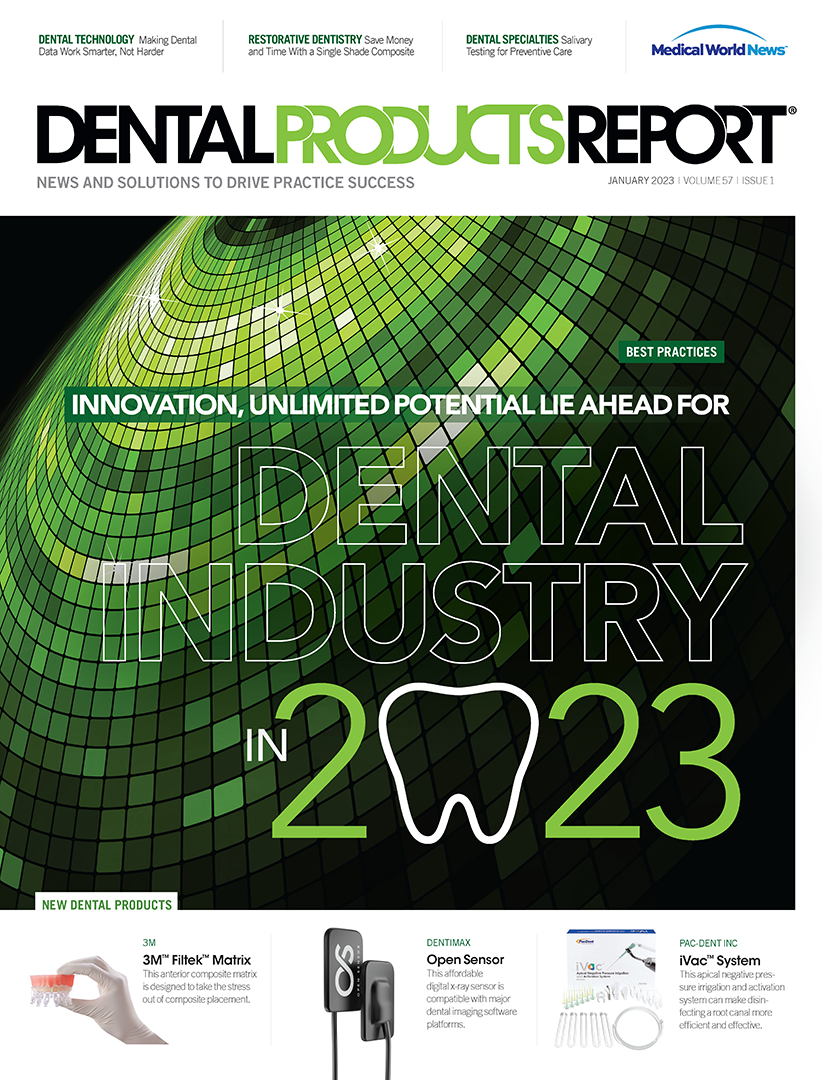The Inexorability of Artificial Intelligence: Where, Why, and How AI Is Being Embraced By the Dental Industry
AI is becoming a mainstay in dentistry. Because its adoption has led to new workflows, dental professionals may want to keep an eye on it.
The Inexorability of Artificial Intelligence: Where, Why, and How AI Is Being Embraced By the Dental Industry. Image courtesy of putilov_denis/stock.adobe.com.

Every practice wants to streamline processes, be it in the operatory or the front office. Over the past few decades, the advent of digital imaging and electronic health records has pushed the industry forward in terms of optimizing workflows. But the progress doesn’t stop there. The integration of artificial intelligence (AI) into the dental practice workflow is making current digital technology look like old news, and the implications for the future are staggering.
“I am really genuinely excited about what is happening in AI and dentistry,” says Ophir Tanz, founder and CEO of Pearl. “Timing is…critical when you’re introducing a fundamentally new capability into a market, and I think that the timing is really perfect for the dental market. I think the adoption is absolutely already there and going to continue to accelerate. It’s our belief that within 5 to 7 years, this will really be a utility within dental practices on a global scale.”
AI in its popular forms—Alexa, Google, and Netflix interfaces—was integrated into our daily life and is now commonplace. Tanz believes that the dental industry isn’t far behind with some AI implementations. We are past the introductory period and moving into a period of adoption, just as we did with consumer-based AI technology.
“We’ve graduated from the very early adopter phase…and are really now at a point where there’s a lot more general awareness globally about the capability, and there’s a lot of interest in it,” Tanz says. “Today AI is this new kind of hot thing that’s highly visible. And that’s all very exciting, but ultimately, it will just become part of the plumbing and be fundamental to how you review radiography and communicate with patients.”
Industry opinion leaders agree that this “plumbing” will soon support all aspects of the dental practice, particularly as the technology continues to expand and to be applied in different areas.
“Currently, we’re seeing AI for caries detection as the breakthrough innovation in dental. However, we also anticipate other use cases, such as auto-charting,” says Eric Giesecke, chief executive officer of Planet DDS. “I believe the pandemic accelerated the development and adoption of new technology within dentistry. Whether you’re looking at the need for cloud-based practice management or imaging software to enable remote working arrangements, allowing…practices to expand their hiring pool geographically, or teledentistry, practices are finding ways to stay resilient through technology.”
Clinical Applications of AI
Perhaps the most highly discussed AI implementations these days are clinical applications like caries identification and diagnostic support tools, which have taken the industry by storm. Such companies as Pearl, Overjet, and VideaHealth are implementing AI for pathology detection and using machine learning to more accurately evaluate radiography for problem areas with greater accuracy.
AI can do this because the software accumulates and stores immense amounts of data and experiential knowledge and creates a reference database that can solve future problems. In dental applications, the data include hundreds of thousands of images for AI to analyze and to learn to identify and differentiate. As more images are input into the system, it learns more and becomes more accurate.
And accurate it is. A 2020 study fed 105 digital radiographs into AI software to determine the accuracy with which it could identify caries and found that it had a 97.1% accuracy rate.1 A 2022 study challenged AI software to detect and label teeth and missing teeth in fully and partially dentate patients, and it did so with a 99% success rate for detection and a 99.7% rate for labeling.2 In a third study, when tasked to identify dental restorations on radiographs, AI algorithms successfully detected 94.6%.3
“By helping highlight suspicious areas in the mouth, we can increase consistency among practitioners and improve diagnostic accuracy,” Giesecke says. “It’s a win-win for patients and dentists when you think about how AI can identify problem areas based on learning from a staggering number of dental images that no human could possibly analyze. AI’s most significant advantage over humans is its ability to learn patterns by analyzing data at an astonishing rate to continually become more effective at what it does.”
There are several options on the market for practitioners looking to integrate AI into their diagnostic process. Pearl’s Second Opinion® platform examines dental x-rays and can detect margin discrepancies, calculus, caries, lesions, periapical radiolucency, fillings, crowns, implants, bridges, and more. The platform is the only one with an FDA clearance for evaluation of periapical x-rays, of patients as young as 12 years old, and of multiple diseases besides caries.
Other options, such as Overjet’s Dental Assist™, has FDA 510(k) clearance for the detection and outlining of decay and for bone level quantification, including measuring distal and mesial bone levels in bitewing and periapical radiographs. Another recipient of the same clearance for caries detection is VideaHealth’s Videa Caries Assist. Its caries detection algorithm enables a more accurate diagnosis, reinforces the benefits of preventative care, and provides cost savings for patients.
Although this technology is inspiring, Tanz says practitioners shouldn’t get too comfortable relying solely on the software. He believes AI should support the dentist, not make all the decisions.
“We’re not looking to take autonomy away from the practitioner,” he says. “The practitioner still has the responsibility to diagnose and treat the condition. We really do think that it is an assistive device. It’s a tool. It’s meant to unburden practitioners, and it’s meant to do one thing incredibly well.”
The technology performs the first evaluation steps for the practitioner, saving time and money, but it’s still up to the doctor to make the subsequent decisions.
“Sometimes the software will identify something that looks like caries, and then the practitioner will want to go in and clinically poke and prod and validate that it really is,” Tanz explains. “We want to circle areas of interest…[for] the practitioner, so that they could go and analyze images more closely because they might have missed it before, or go into the mouth and check things clinically. And we want them not only to make the final diagnostic decision, but also to make the treatment decision. They can determine that, given the confluence of pathology,…here’s the course of action we should take.”
AI isn’t just being used to detect disease; it’s also been found to be incredibly helpful in treatment planning. SoftSmile’s VISION treatment-planning software automates the technical planning steps and handles difficult calculations so that the clinician can focus on treatment strategy. Because of its intuitive, comprehensive nature, it allows clinicians of varying experience levels to manage clear-aligner workflows and cases that they previously would have had to outsource. The algorithms streamline every step, guiding clinicians through preprocessing, setup, and postprocessing. By automating processes like contouring, segmentation, staging, and fabrication, SoftSmile takes a lot of the tricky work out of the clinician’s hands, increasing accuracy while simplifying corrections.
Other companies are taking a more long-distance approach. DentalMonitoring uses AI to remotely detect and track more than 130 observations in orthodontic treatment, allowing clinicians to supervise patient progress, determine when an in-person appointment is required—and save themselves time and their patients money. Clinicians see a patient in office and determine a treatment plan, then give patients a ScanBoxpro device that allows them to take intraoral photos with a smartphone. Patients can upload the images into the platform, which analyzes, crops, and sorts the images automatically for the clinician. AI algorithms examine the images to detect oral condition and estimate tooth movement. Clinicians are notified of any changes, and if a prescribed observation is detected, customized protocols and instructions are sent.
AI in Practice Management
But AI doesn’t have only clinical benefits. It allows practices to delegate time-consuming tasks, ensure continuity, and eliminate manual processes to streamline the front office.
“By reducing administrative work, AI frees up time for dentists and staff members to focus on improving the patient experience in other, more important areas,” Giesecke says. “If anything, the AI and automation is designed to help increase the quality and frequency of human interactions.”
Giesecke sees a future in which AI options continue to flourish, as companies continue to implement new automated strategies.
“We are always looking for innovative ways to deliver more value to our customers,” Giesecke says. “AI is a revolutionary technology that we can’t wait to incorporate into our solutions. The AI capabilities we look forward to delivering will help streamline workflows, reduce administrative tasks, and improve job satisfaction for dental office staff.”
And AI is touching every aspect of practice management and marketing. Comprehensive, cloud-based management solutions like Planet DDS’s Denticon are already saving practices time and ensuring consistency by centralizing data. Planet DDS isn’t stopping there but is planning new integrations to its Apteryx XVWeb platform, including such features as auto-charting. For this to occur, AI would analyze panoramic x-rays, segment and number the teeth, identify pathologies, and automatically upload the images into the practice management system’s charting files. This would result in less charting time, fewer opportunities for clerical errors, and more efficiency.
Other automated practice-management platforms are also already making a big difference. For instance, MMG Fusion’s MMG Manage software helps track and improve staff performance through the automatic creation of actionable checklists for team members to complete. It is essentially a ticket system that automatically delegates tasks. Claims have also been simplified through AI: Vyne Dental is using AI technology for electronic claims submissions, offering real-time, end-of-day viewing and status updates, and eliminating the need for extra time spent on claims tracking.
Marketing has also been impacted: MMG Fusion’s Chairfill analyses a practice’s schedule to identify patients who may need follow-up treatment, creates targeted campaigns to reach them individually, and books patients who respond into available chair time. Other companies, like Scorpion, are using AI technology to leverage data to identify traits and attributes among different patient demographics, which in turn allows the software to delegate ad spending and optimize ad placement.
And the operatory also has not gone untouched by workflow advances in AI. Natural-language processing technology is a branch of AI that applies algorithms allowing software to understand language. Technology like DEXVoice for the DEXIS Imaging Suite lets dentists integrate voice activation into the operatory, so they can pull charts and images through voice commands without the need for touching a computer or screen.
All these technologies are changing the way dental practices operate—for the better. And growth is only predicted to continue.
“I believe we are barely scratching the surface of what implications there will be for AI in dentistry,” Giesecke says. “I’m excited to see how it will unfold in the coming years as we continue to add to our software capabilities.”
References
- Geetha V, Aprameya KS, Hinduja DM. Dental caries diagnosis in digital radiographs using back-propagation neural network. Health Inf Sci Syst. 2020;8(1):8. Published 2020 Jan 3. doi:10.1007/s13755-019-0096-y
- Fontenele RC, Gerhardt MDN, Pinto JC, et al. Influence of dental fillings and tooth type on the performance of a novel artificial intelligence-driven tool for automatic tooth segmentation on CBCT images – A validation study. J Dent. 2022;119:104069. doi:10.1016/j.jdent.2022.104069
- Abdalla-Aslan R, Yeshua T, Kabla D, Leichter I, Nadler C. An artificial intelligence system using machine-learning for automatic detection and classification of dental restorations in panoramic radiography. Oral Surg Oral Med Oral Pathol Oral Radiol. 2020;130(5):593-602.
